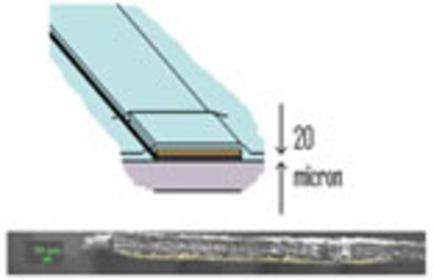当前位置:
X-MOL 学术
›
Electroanalysis
›
论文详情
Our official English website, www.x-mol.net, welcomes your
feedback! (Note: you will need to create a separate account there.)
Microband Sensor for As(III) Analysis: Reduced Matrix Interference
Electroanalysis ( IF 2.7 ) Pub Date : 2017-07-19 , DOI: 10.1002/elan.201700242 Richard Dudeney 1 , Jeffrey D. Newman 1 , Frank Davis 2 , Steven J. Setford 3 , Ibtisam E. Tothill 1
Electroanalysis ( IF 2.7 ) Pub Date : 2017-07-19 , DOI: 10.1002/elan.201700242 Richard Dudeney 1 , Jeffrey D. Newman 1 , Frank Davis 2 , Steven J. Setford 3 , Ibtisam E. Tothill 1
Affiliation

|
A portable sensor based on a microband design for arsenic detection in drinking water is presented. The work was focused to minimize interference encountered with a standard screen-printed electrodes featuring an onboard gold working electrode, carbon counter and silver−silver chloride pseudo-reference electrodes as composite coatings on plastic surface. The interference effect was identified as chloride ions interacting with the silver surface of the reference electrode and formation of soluble silver chloride complexes such as AgCl43−. By modification of the reference electrodes with Nafion membrane (5 % in alcohols), the interference was entirely eliminated. However, membrane coverage and uniformity can impact the electrodes reproducibility and performance. Hence, the sensor design was further considered and a microband format was produced lending favorable diffusive to capacitive current characteristics. Using the microband electrodes allowed As(III) detection with limit of detection of 0.8 ppb (in 4 M HCl electrolyte), inherently avoiding the problems of electrode fouling and maximizing analyte signal in river water samples. This is below the World Health Organization limit of 10 μg L−1 (ppb). The electrolyte system was chosen so as to avoid problems from other common metal ions, most notably Cu(II). The presented electrode system is cost effective and offers a viable alternative to the colorimetric test kits presently employed for arsenic analysis in drinking water.
中文翻译:

用于 As(III) 分析的微带传感器:减少基质干扰
提出了一种基于微带设计的便携式传感器,用于饮用水中的砷检测。这项工作的重点是尽量减少标准丝网印刷电极遇到的干扰,该电极具有板载金工作电极、碳计数器和银-氯化银伪参考电极作为塑料表面的复合涂层。干扰效应被确定为氯离子与参比电极的银表面相互作用并形成可溶性氯化银络合物,如 AgCl43-。通过使用 Nafion 膜(含 5% 的酒精)修改参比电极,完全消除了干扰。然而,膜覆盖率和均匀性会影响电极的重现性和性能。因此,进一步考虑了传感器设计,并产生了一种微带格式,有利于电容电流特性的扩散。使用微带电极允许 As(III) 检测,检测限为 0.8 ppb(在 4 M HCl 电解质中),从本质上避免了电极污染问题并最大化河水样品中的分析物信号。这低于世界卫生组织 10 μg L-1 (ppb) 的限值。选择电解质系统是为了避免其他常见金属离子的问题,最显着的是 Cu(II)。所提出的电极系统具有成本效益,并且为目前用于饮用水中砷分析的比色测试套件提供了可行的替代方案。使用微带电极允许 As(III) 检测,检测限为 0.8 ppb(在 4 M HCl 电解质中),从本质上避免了电极污染问题并最大化河水样品中的分析物信号。这低于世界卫生组织 10 μg L-1 (ppb) 的限值。选择电解质系统是为了避免其他常见金属离子的问题,最显着的是 Cu(II)。所提出的电极系统具有成本效益,并且为目前用于饮用水中砷分析的比色测试套件提供了可行的替代方案。使用微带电极允许 As(III) 检测,检测限为 0.8 ppb(在 4 M HCl 电解质中),从本质上避免了电极污染问题并最大化河水样品中的分析物信号。这低于世界卫生组织 10 μg L-1 (ppb) 的限值。选择电解质系统是为了避免其他常见金属离子的问题,最显着的是 Cu(II)。所提出的电极系统具有成本效益,并且为目前用于饮用水中砷分析的比色测试套件提供了可行的替代方案。选择电解质系统是为了避免其他常见金属离子的问题,最显着的是 Cu(II)。所提出的电极系统具有成本效益,并且为目前用于饮用水中砷分析的比色测试套件提供了可行的替代方案。选择电解质系统是为了避免其他常见金属离子的问题,最显着的是 Cu(II)。所提出的电极系统具有成本效益,并且为目前用于饮用水中砷分析的比色测试套件提供了可行的替代方案。
更新日期:2017-07-19
中文翻译:

用于 As(III) 分析的微带传感器:减少基质干扰
提出了一种基于微带设计的便携式传感器,用于饮用水中的砷检测。这项工作的重点是尽量减少标准丝网印刷电极遇到的干扰,该电极具有板载金工作电极、碳计数器和银-氯化银伪参考电极作为塑料表面的复合涂层。干扰效应被确定为氯离子与参比电极的银表面相互作用并形成可溶性氯化银络合物,如 AgCl43-。通过使用 Nafion 膜(含 5% 的酒精)修改参比电极,完全消除了干扰。然而,膜覆盖率和均匀性会影响电极的重现性和性能。因此,进一步考虑了传感器设计,并产生了一种微带格式,有利于电容电流特性的扩散。使用微带电极允许 As(III) 检测,检测限为 0.8 ppb(在 4 M HCl 电解质中),从本质上避免了电极污染问题并最大化河水样品中的分析物信号。这低于世界卫生组织 10 μg L-1 (ppb) 的限值。选择电解质系统是为了避免其他常见金属离子的问题,最显着的是 Cu(II)。所提出的电极系统具有成本效益,并且为目前用于饮用水中砷分析的比色测试套件提供了可行的替代方案。使用微带电极允许 As(III) 检测,检测限为 0.8 ppb(在 4 M HCl 电解质中),从本质上避免了电极污染问题并最大化河水样品中的分析物信号。这低于世界卫生组织 10 μg L-1 (ppb) 的限值。选择电解质系统是为了避免其他常见金属离子的问题,最显着的是 Cu(II)。所提出的电极系统具有成本效益,并且为目前用于饮用水中砷分析的比色测试套件提供了可行的替代方案。使用微带电极允许 As(III) 检测,检测限为 0.8 ppb(在 4 M HCl 电解质中),从本质上避免了电极污染问题并最大化河水样品中的分析物信号。这低于世界卫生组织 10 μg L-1 (ppb) 的限值。选择电解质系统是为了避免其他常见金属离子的问题,最显着的是 Cu(II)。所提出的电极系统具有成本效益,并且为目前用于饮用水中砷分析的比色测试套件提供了可行的替代方案。选择电解质系统是为了避免其他常见金属离子的问题,最显着的是 Cu(II)。所提出的电极系统具有成本效益,并且为目前用于饮用水中砷分析的比色测试套件提供了可行的替代方案。选择电解质系统是为了避免其他常见金属离子的问题,最显着的是 Cu(II)。所提出的电极系统具有成本效益,并且为目前用于饮用水中砷分析的比色测试套件提供了可行的替代方案。











































 京公网安备 11010802027423号
京公网安备 11010802027423号